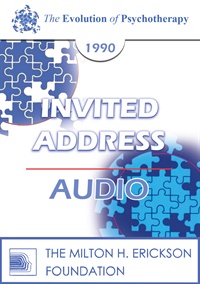
- Average Rating:
- Not yet rated
- Topic Areas:
- Invited Addresses | Psychotherapy | Cognitive Behavior Therapy (CBT)
- Categories:
- Evolution of Psychotherapy | Evolution of Psychotherapy 1990
- Faculty:
- Donald Meichenbaum, PhD | Albert Ellis, PhD
- Duration:
- 1 Hour 26 Minutes
- Format:
- Audio Only
- Original Program Date:
- Dec 13, 1990
- Short Description:
- The field of psychotherapy is moving toward an integrative approach, both in terms of theory and practice. Meichenbaum will discuss how Cognitive-Behavior Modification attempts to integrate, on the one hand, the clinical concerns of psychodynamic and interpersonal/systems approaches with the technology of behavior therapy on the other hand. He will trace the history of Cognitive-Behavior Modification and examine its future directions. Common clinical treatment issues, such as client resistance, patient noncompliance, and treatment nonadherence that all psychotherapists face will also be considered.
- Price:
- $15.00 - Base Price
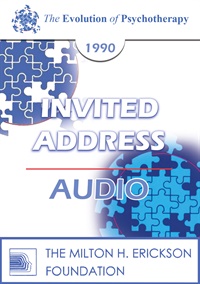
- Average Rating:
- Not yet rated
- Topic Areas:
- Invited Addresses | Panic | Psychotherapy | History of Psychotherapy | Therapist Development
- Categories:
- Evolution of Psychotherapy | Evolution of Psychotherapy 1990
- Faculty:
- Arnold Lazarus, Ph.D. | Jay Haley, MA
- Duration:
- 1 Hour 11 Minutes
- Format:
- Audio Only
- Original Program Date:
- Dec 13, 1990
- Short Description:
- Ten myths, some contradictory, some interconnected, are outlined, followed by a fairly detailed exposition and rebuttal. The treatment of a young man with panic disorder is discussed as an exemplar of the need to apply data-based treatments of choice within the context of clinical artistry. Technical eclecticism is defined and is offered as a possible solution to many common misconceptions.
- Price:
- $15.00 - Base Price
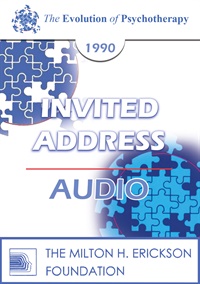
- Average Rating:
- Not yet rated
- Topic Areas:
- Invited Addresses | Trauma | Brief Therapy | Children and Adolescent Therapy | Psychotherapy | Redecision Therapy
- Categories:
- Evolution of Psychotherapy | Evolution of Psychotherapy 1990
- Faculty:
- Mary Goulding, MSW | Judd Marmor
- Duration:
- 1 Hour 26 Minutes
- Format:
- Audio Only
- Original Program Date:
- Dec 13, 1990
- Short Description:
- Today and in the immediate future, short-term therapy is a major available treatment for most clients. In this paper, I will discuss the use of Short-Term Redecision Therapy in the resolution of major childhood traumas, such as physical, sexual, and mental abuse. In Redecision Therapy, the client remembers, re-enacts, uses therapeutically, and then discards these early traumatic scenes.
- Price:
- $15.00 - Base Price
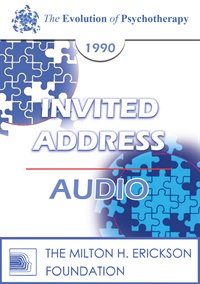
- Average Rating:
- Not yet rated
- Topic Areas:
- Invited Addresses | Ericksonian Hypnosis and Therapy Techniques | Psychotherapy | Treatment Planning | Therapist Development
- Categories:
- Evolution of Psychotherapy | Evolution of Psychotherapy 1990
- Faculty:
- Jeffrey Zeig, PhD | James F. Masterson, MD
- Duration:
- 1 Hour 15 Minutes
- Format:
- Audio Only
- Original Program Date:
- Dec 13, 1990
- Short Description:
- This paper surveys a key concept of Ericksonian therapy. Cornerstone principles of an Erickson ian approach are presented and illustrated. The method can be incorporated into any psychotherapeutic discipline in order to enhance effectiveness.
- Price:
- $15.00 - Base Price
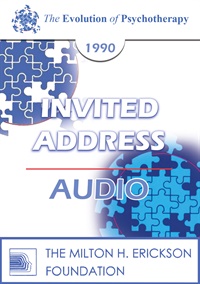
- Average Rating:
- Not yet rated
- Topic Areas:
- Invited Addresses | Psychotherapy | Therapist Development
- Categories:
- Evolution of Psychotherapy | Evolution of Psychotherapy 1990
- Faculty:
- Paul Watzlawick, PhD | Cloe Madanes, HDL, LIC
- Duration:
- 1 Hour 28 Minutes
- Format:
- Audio Only
- Original Program Date:
- Dec 14, 1990
- Short Description:
- The criterion of reality adaptation as a measure of mental health or pathology is a totally fictitious one, since what reality "really" is remains an arbitrary definition which, in turn, leads to a reification. However, out of these reifications can grow very important practical consequences - both positive and negative ones.
- Price:
- $15.00 - Base Price
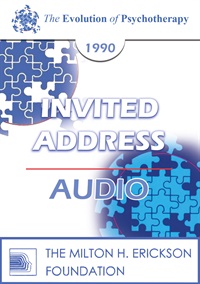
- Average Rating:
- Not yet rated
- Topic Areas:
- Invited Addresses | Schizophrenia | Children and Adolescent Therapy | Family Therapy | Psychotherapy | Relationships | Personality Disorders
- Categories:
- Evolution of Psychotherapy | Evolution of Psychotherapy 1990
- Faculty:
- Mara Selvini Palazzoli, MD | Donald Meichenbaum, PhD
- Duration:
- 1:31:23
- Format:
- Audio Only
- Original Program Date:
- Dec 14, 1990
- Short Description:
- We shall discuss one of the most frequent family processes leading to adolescent psychosis. As a direct consequence of the couple's hidden relational malaise, one of the two parents pseudo-privileges the child over the spouse and instrumentally brings him/her up as the opposite of the spouse in every way. The involuntary cheating about feelings ("imbroglio of affections") enhances the possibility of a psychotic breakdown.
- Price:
- $15.00 - Base Price
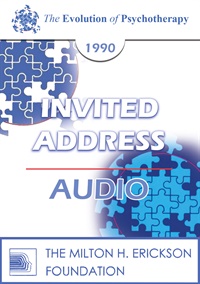
- Average Rating:
- Not yet rated
- Topic Areas:
- Invited Addresses | Rational Emotive Behavior Therapy (REBT) | Belief Systems | Cognitive Behavior Therapy (CBT) | Psychotherapy
- Categories:
- Evolution of Psychotherapy | Evolution of Psychotherapy 1990
- Faculty:
- Albert Ellis, PhD | Salvador Minuchin, MD
- Duration:
- 1 Hour 28 Minutes
- Format:
- Audio Only
- Original Program Date:
- Dec 14, 1990
- Short Description:
- This revision of the original ABCs of RET and cognitive-behavior therapy shows that people's Belief System (B) about their Activating Events (A) of their lives largely contribute to their emotional and behavioral Consequences (C) but that A, B, and C importantly influence and include each other and that all three include interacting cognitive, emotive, and behavioral elements.
- Price:
- $15.00 - Base Price
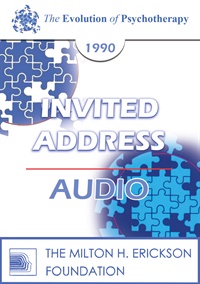
- Average Rating:
- Not yet rated
- Topic Areas:
- Invited Addresses | Depression | Psychotherapy | Therapist Development
- Categories:
- Evolution of Psychotherapy | Evolution of Psychotherapy 1990
- Faculty:
- Joseph Wolpe, M.D. | Thomas Szasz, MD
- Duration:
- 1:24:43
- Format:
- Audio Only
- Original Program Date:
- Dec 14, 1990
- Short Description:
- Accepted thinking about non-polar, non-psychotic depression has been impaired by ignoring crucial research. This shows that some cases are masked endogenous depression; others are anxiety-based in several ways. Therefore, each case must be investigated to decide appropriate treatment and thus surpass the mediocre results typified in the "Collaborative Study."
- Price:
- $15.00 - Base Price
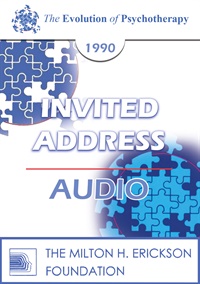
- Average Rating:
- Not yet rated
- Topic Areas:
- Invited Addresses | Bioenergetics | Mind-Body | Psychotherapy
- Categories:
- Evolution of Psychotherapy | Evolution of Psychotherapy 1990
- Faculty:
- Alexander Lowen, MD | Miriam Polster
- Duration:
- 1 hour 28 minutes
- Format:
- Audio Only
- Original Program Date:
- Dec 14, 1990
- Short Description:
- Recognition of body-mind unity requires acceptance of the fact that the body in its form and motility expresses the individual's personality as much as behavior and thinking. If there is to be a change in personality, the body must reflect that change. To change bodily attitude, one should work directly with the energy dynamics of the body. By mobilizing a person's energy, one opens up deep feelings that are otherwise inaccessible. This is critical in the treatment of depression which is directly connected to an energetic collapse in the body. The address will describe how one increases an individual's energy to promote his pleasure in life.
- Price:
- $15.00 - Base Price
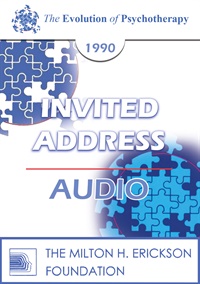
- Average Rating:
- Not yet rated
- Topic Areas:
- Invited Addresses | Consciousness | Mind-Body | Psychotherapy | Psychosomatics | Stress
- Categories:
- Evolution of Psychotherapy | Evolution of Psychotherapy 1990
- Faculty:
- Ernest Rossi, PhD | Carl Whitaker, MD
- Duration:
- 1:25:21
- Format:
- Audio Only
- Original Program Date:
- Dec 14, 1990
- Short Description:
- Evidence that the hourly and daily variations in our consciousness are related to the wavelike flow of messenger molecules operating on all levels from mind to gene will be reviewed. Stress, psychosomatic problems, and their resolution are a function of how we manage this wave nature of our consciousness. How do we create a new psychotherapy for the future that utilizes these natural windows of the mindbody?
- Price:
- $15.00 - Base Price
Please wait ...

